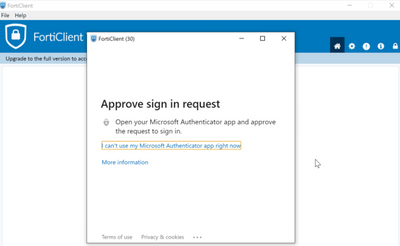- Support Forum
- Knowledge Base
- Customer Service
- Internal Article Nominations
- FortiGate
- FortiClient
- FortiADC
- FortiAIOps
- FortiAnalyzer
- FortiAP
- FortiAuthenticator
- FortiBridge
- FortiCache
- FortiCare Services
- FortiCarrier
- FortiCASB
- FortiConverter
- FortiCNP
- FortiDAST
- FortiData
- FortiDDoS
- FortiDB
- FortiDNS
- FortiDLP
- FortiDeceptor
- FortiDevice
- FortiDevSec
- FortiDirector
- FortiEdgeCloud
- FortiEDR
- FortiEndpoint
- FortiExtender
- FortiGate Cloud
- FortiGuard
- FortiGuest
- FortiHypervisor
- FortiInsight
- FortiIsolator
- FortiMail
- FortiManager
- FortiMonitor
- FortiNAC
- FortiNAC-F
- FortiNDR (on-premise)
- FortiNDRCloud
- FortiPAM
- FortiPhish
- FortiPortal
- FortiPresence
- FortiProxy
- FortiRecon
- FortiRecorder
- FortiSRA
- FortiSandbox
- FortiSASE
- FortiSASE Sovereign
- FortiScan
- FortiSIEM
- FortiSOAR
- FortiSwitch
- FortiTester
- FortiToken
- FortiVoice
- FortiWAN
- FortiWeb
- FortiAppSec Cloud
- Lacework
- Wireless Controller
- RMA Information and Announcements
- FortiCloud Products
- ZTNA
- 4D Documents
- Customer Service
- Community Groups
- Blogs
- Fortinet Community
- Knowledge Base
- FortiGate
- Technical Tip: SSL VPN with Azure SAML authenticat...
- Subscribe to RSS Feed
- Mark as New
- Mark as Read
- Bookmark
- Subscribe
- Printer Friendly Page
- Report Inappropriate Content
Created on
06-01-2022
08:06 AM
Edited on
11-06-2025
06:01 AM
By
![]() Stephen_G
Stephen_G
| Description | This article describes SSL VPN with Azure SAML authentication with multi-factor authentication(MFA). |
| Scope | FortiGate, FortiClient. |
| Solution |
Azure Multi-factor authentication can be enabled for SSL VPN with SAML authentication. This can be done by enabling multi-factor authentication on Azure.
No additional settings are required on FortiGate. However, it is important to check whether the authentication timeout for remote servers is long enough for the user to authorize the challenge (MFA).
The MFA window will pop out after entering a credential, as the screenshot below.

CLI:
diagnose debug disable
[249:root:1d]fsv_rmt_saml_login_cb:111 magic id: magic=6-5ccdgb9874tec5f4
This might not be caused by FortiGate, and the timeout might be controlled by the SAML provider or FortiClient timeout settings.
Make sure that the timeout settings in Azure and FortiClient are configured correctly.
In some other cases, after entering SAML credentials and completing MFA, the FortiClient shows as 'connected' but then immediately ends the session.
The following output is generated from the SAML debug:
[273:root:e0]fsv_saml_login_response:490 Got group username: xxxxxxxx-xxxx-xxxx-xxxx-xxxxxxxxxxxx.
To resolve this issue, ensure that the username attribute in the SAML configuration is set to the same value on both the FortiGate and Azure side.
config user saml
In SSL VPN deployments using Azure SAML authentication, MFA is triggered and enforced entirely on the Azure side. FortiGate acts only as a SAML Service Provider and receives the authentication result (SAML assertion) from Azure, which includes attributes such as username and group claims. FortiGate does not perform or enforce MFA itself, it simply evaluates the claims to allow or deny VPN access. Therefore, any issues with MFA should be investigated on the Azure side, as FortiGate has no control over the MFA process.
Microsoft Azure Tutorial: Secure user sign-in events with Microsoft Entra multifactor authentication |
The Fortinet Security Fabric brings together the concepts of convergence and consolidation to provide comprehensive cybersecurity protection for all users, devices, and applications and across all network edges.
Copyright 2025 Fortinet, Inc. All Rights Reserved.
